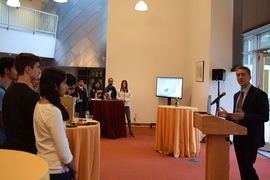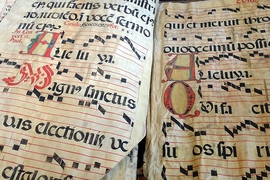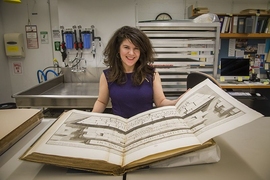In his first week at MIT, Assistant Professor Admir Masic of the Department of Civil and Environmental Engineering (CEE) approaches a cluster of students at the department’s graduate program reception. “I research ancient manuscripts and materials,” he says by way of introduction, then eagerly pulls a small box from his jacket pocket. Inside are two pea-sized pieces of the Dead Sea Scrolls — 2,000-year-old slices of animal skin on which prophetic lessons about how people should treat each other are inscribed.
As the students lean in to inspect the bits of scroll, Masic (pronounced "MASH-itch") explains that he obtained the materials from the Federal Institute for Materials Research and Testing in Berlin. The pieces are from a collection compiled by Ronald Reed, the first scientist who studied the scrolls in the 1950s. They had been secured in his attic after he passed away, and since 1996 kept in the John Rylands Library in Manchester. Although small, the samples are pristine, and all that Masic needs for his research.
One of the students mentions Masic’s accent. “I’m a conglomeration of many nationalities,” he explains. “I was born in ex-Yugoslavia, but grew up mostly in Bosnia and Herzegovina, then spent time in Croatia, Italy, and Germany.”
Like the pieces of scroll, this is only a fragment of Masic’s story. This "man of many countries" spent his early teens in a refugee camp in Croatia during the Bosnian War of 1992; he was also separated from his parents and two sisters at age 16, because he stayed in Croatia to continue his education when the rest of his family moved to Germany where his father found work. Masic’s education at the time consisted of auditing classes in a Croatian technical high school through the generosity of one of the school’s instructors. He couldn’t officially enroll because of his refugee status, so he sat in the back of the room trying to be unobtrusive. A local family took him in and provided a small bed in the corner of their apartment, which got him out of the camps.
He got an even bigger break soon after, when some Italian benefactors and the George Soros-funded Open Society Foundations (OSF) provided him with financial support. Masic studied diligently and won a prestigious national chemistry award; meanwhile, Croatian laws were changed just in time for him to be awarded his high school diploma. He went on to study biological materials and chemistry, and he earned a doctorate in physical chemistry from the University of Turin in Italy.
Coming by his interest — and his expertise — in resilience so personally, it’s no surprise that Masic’s research has gone down a related road. His professional pursuits encompass interdisciplinary research into materials and ways to make them more resilient. “What can nature teach us?” he asks. “Ultimately, we want to ensure that things we create today are durable and can last for generations, especially considering the impacts caused by man and environmental degradation. How can we overcome the challenges of scaling growth and innovation?”
Masic’s vision is to merge as much of the real world with the lab as possible. He wants to take students into the field using handheld, miniature lab tools that allow them to investigate organisms as well as infrastructure in their natural environments, and then extend this research back at the Institute using sophisticated microscopes that record how molecules interact at the nanoscale. Data systems then would combine both new and existing data, to uncover new insights and lead to structural innovations for a new age. “There’s so much we have yet to discover that we can apply to help mitigate material degradation and build resilience,” he said. “Natural disasters, climate change, pollution, wars, are only few examples of threats to our heritage and future infrastructure. Civilization is at a new inflection point and we need to act now.”
These thoughts on basic biology, chemistry, and material science, and their possible application to the physical world, have other analogs as well, Masic notes. “It breaks my heart to see what’s happening in Syria now,” he says. “Not only the lost lives, but the lost opportunities for the youth. I’ve lived their experience. I know how important and fleeting time is. I want to do something now to help.”
Masic plans to work with in-country schools and libraries and wants to see new programs established and funded that would allow refugees to take university courses online through its edX initiative, perhaps with some customization for the unique populations that are being affected. “Everyone benefits,” he explains. “The students with a thirst for knowledge can continue their education and perhaps even enroll at MIT someday. The in-country community benefits by directing seemingly extraneous populations onto productive paths without overloading their education infrastructure, and it could eventually infuse new talents and skills into their economies.”
Masic is a living example of how small change can create large-scale impact, because he was given a chance early on. And the positive energy and enthusiasm he exudes for research and teaching is already making a difference for students in CEE. Though Masic just joined the department on Sept. 1, CEE senior Ruben Amaez '16 has already approached him to do his Undergraduate Research Opportunity Program (UROP) and undergraduate capstone project on material resiliency. “I want to work together to uncover the secrets of the Dead Sea Scrolls and maybe do some field work in Rome studying ancient structures,” Amaez says.
The MIT community can meet Masic on Oct. 21 when he describes his research as one of five CEE faculty presenting at the 3rd annual CEE Alumni Research Breakfast. The event will take place from 7:30 to 9:30 a.m. in the Bush Room (Room 10-105) and also will be streamed live starting at 7:45 a.m.











